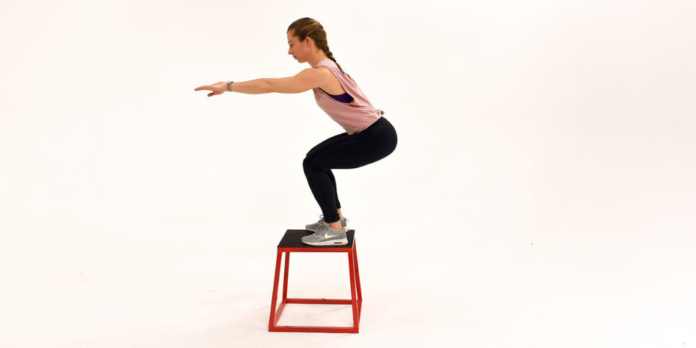Field jumps have reached a tipping level within the health world. Stroll into any gymnasium, HIIT studio, or CrossFit field, and also you’ll inevitably discover somebody repeatedly hopping on and off a field, step, or bench. The lure of the field bounce is comprehensible; they’re a difficult and enjoyable plyometric train, which, when carried out appropriately, not solely look cool, but in addition construct explosive energy.
However when field jumps go improper, they’ve the potential to go actually, actually improper. (Simply Google “gymnasium fails” for proof.) And even when field bounce errors don’t finish in an embarrassing fall, they’ll, over time, take a toll on the jumper and result in continual harm.
If you wish to incorporate field jumps into your common exercise routine, it’s value your time to first perceive how you can do them safely and successfully.
Field Jumps: Step-by-Step Directions
Begin with the suitable field top — about knee-high or decrease. Whereas the viral movies of professional athletes clearing five-foot-tall bins are spectacular, Pete McCall, grasp coach and creator of Smarter Exercises: The Science of Train Made Easy, cautions towards utilizing field jumps to problem your individual vertical aptitude.
“The danger of harm is critical, whether or not it’s a blown Achilles tendon or falling off a field,” he says. Plus, leaping onto a field taller than knee top is extra of a hip mobility train than a plyometric one.
- Stand dealing with the field (or different steady elevated floor) together with your toes hip-width aside, and bend your knees into 1 / 4 squat, bringing each arms behind you.
- Swing your arms ahead and bounce up and onto the field, touchdown together with your knees bent and each toes on the center of the field.
- Rise up, after which step down from the field one foot at a time. “By no means bounce off the field,” cautions Trevor Thieme, C.S.C.S., including it’s not definitely worth the impression in your joints. “The potential efficiency advantages don’t outweigh the elevated danger of harm.”
It’s greatest to do field jumps after a fast warm-up firstly of your exercise. After a cardio or power session your leg muscle tissue usually tend to be fatigued.
Thieme recommends maintaining your units at six to 10 reps and resting in between. “As with all power-focused train, you need to permit loads of relaxation (one and a half to 2 minutes) between units to keep up a excessive degree of efficiency,” he says.
Muscle mass Labored by Field Jumps
Field jumps can construct energy, power, and dimension in your decrease physique muscle tissue:
Advantages of Field Jumps
It doesn’t matter what you do in or out of the gymnasium, field jumps present a great deal of advantages.
Enhance power and energy
“The field bounce’s main profit helps you construct explosive energy, which is a crucial ability in nearly each sport — and in on a regular basis life.”
Athletes of each sport and skill degree — pick-up basketball gamers, seaside volleyball execs, leisure highway racers — can profit from field jumps, as they aim the physique’s sort II muscle fibers, McCall says.
“Kind II muscle fibers are liable for creating power and explosive energy,” he explains. “Field jumps are probably the greatest methods to do this since you’re performing fast muscle motion in a really quick time frame.” If you wish to bounce increased, practice for faster leg turnover throughout a run, or simply transfer sooner usually, field jumps will help develop your energy and velocity.
Construct and tone muscle
And if the way you look in denims is extra essential than your 5k time, field jumps will help there too.
“For individuals who need to work on their lower-body aesthetics, leaping is a good way to go,” McCall says. “Field jumps goal the quads, glutes, and hamstrings, they usually activate the kind II fibers, which contribute extra to muscle definition and dimension.”
Methods to Work As much as a Field Leap
In case you’re new to field jumps, Thieme recommends beginning with body weight plyometric workout routines like squat jumps and cut up jumps.
When you’re snug with primary plyometric coaching, you possibly can strive field jumps with a shorter field; even a platform that’s 12 inches or decrease can provide a problem whereas serving to you develop the mandatory power and coordination for field jumps.
Thieme recommends together with field jumps or different plyometric actions into your exercise routine two to a few instances per week. Nevertheless, newbies ought to persist with a smaller rep scheme of not more than three or 4 consecutive jumps per set, in keeping with McCall.

